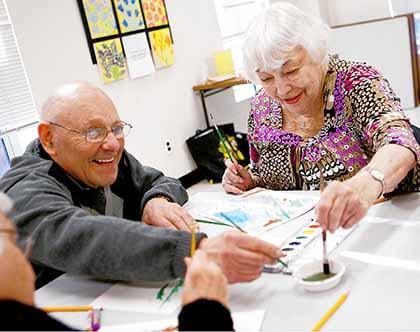By Anna Gustafson
As the Queens seniors looked at the wild brush strokes in Vincent van Gogh’s sky in “Starry Night,” they wondered aloud if the painting represented something internal for the artist — a chaos that was happening in van Gogh’s mind, they said.
For the adults at the Samuel Field Y in Little Neck who discussed art with a teacher from the Museum of Modern Art last Thursday, this idea was something to which they could relate — each of them is part of the Y’s Memory Care Program and is suffering from Alzheimer’s or another type of dementia.
Programs like this one, during which the adults interpreted the “wildness” in van Gogh’s “Starry Night” as a sign that the painter like them could have a loose grip on reality, gave the participants an important outlet to not only think about their own condition but a creativity that helps maintain cognitive ability, program leaders said.
“It gives them a sense of purpose, that their thoughts are relevant,” said Amanda Williams, a museum educator with community and access programs at MoMA, which provided the program at the Samuel Field Y last week for free. “They know they’re going through this, but they don’t always have the clarity to express what it is they’re going through. This gives them moments to feel like themselves again.”
The Samuel Field Y is at 58-20 Little Neck Pkwy.
Williams led the hour-long class last week, during which about 25 adults who suffer from both early and late stages of dementia analyzed the van Gogh painting and George Seurat’s “Port-en-Bessin.” They also made their own paintings.
Hollis Hills resident Mildred Schwartz said she loved the art lesson, which she said gave program participants a chance to be “very creative.”
“The painting I did today, it helps to keep your mind busy,” said Schwartz, a former elementary school teacher. “It means you did something today. You’re stimulated during the time you’re here. It’s a very fulfilling experience.”
Nanette Jiji, an artist from New Jersey whose father once participated in the Samuel Field program and helped to coordinate the event, said she hoped the class would bring some light to lives that can often be fraught with difficulties.
“My father took such pride in the artwork he did here,” Jiji said. “He was an avid reader and he was no longer able to really take in what he was reading, but when he was in the world of painting or creating, for that time there was no Alzheimer’s for him.”
The Y’s early stage memory group has been around for 11 years and the respite memory group for about 25 years, which provide participants with a wide variety of programs, including talks on cultural events and field trips to museums.
“There are discussions about sexuality, relationships, giving up work and driving, losing friendships, their fears about moving on in the illness,” said Alissa Pizzutiello, director of the early stage memory program at the Y.
Jamie Cooperman, director of the respite program, said events like the art class help the adults to maintain their cognitive function.
“They leave saying it’s wonderful to be here,” Cooperman said.
Rosemarie Hicks of Little Neck said the program makes her “want to get up in the morning.”
“If I didn’t have this to come to, if I didn’t have to go out, I probably wouldn’t even get dressed,” Hicks said. “You feel like you’re back in focus and back in the groove.”
May Ladman, also of Little Neck, said the class was “one of the most creative times I’ve had in this program.”
“It’s stimulating not only the senses, but the thoughts,” she said.
Reach reporter Anna Gustafson by e-mail at agustafson@cnglocal.com or by phone at 718-260-4574.

































